-De-noising is used to remove the noise from corrupted image, while retaining the edges and other detailed features as much as possible.. Filtering of these images is required to maximize the original content and suppress the effect of noise generated from random source. In this paper, we have evaluated and compared performances of modified de-noising method and the local adaptive real oriented dual tree wavelet image de-noising method. We have evaluated and compared performances of modified de-noising method and the local adaptive real oriented dual tree wavelet image de-noising method. These methods are compared with other based on PSNR (Peak signal to noise ratio) between original image and noisy image and PSNR between original image and de-noised image.
Keywords |
| De-noising Method, Thresholding, Dual Tree Wavelet Transform, Noise Modelling and Filter. |
INTRODUCTION |
| Image:-Digital images play an important role both in daily life applications such as satellite television, computer
tomography as well as in areas of research and technology such as geographical information systems and astronomy. In
reality, an image is mixed with certain amount of noise which decreases visual quality of image. Therefore, removal of
noise in an image is a very common problem.An image was corrupted with noise during acquisition or at transmission
due to channel errors or in storage media due to faulty hardware. A digital image is usually programmed as a matrix
which contains a collection of grey level or color values. In videos, this matrix has three dimensions, the third one
related to time. |
| Noise Modelling:-Noise may be classified as substitutive noise (impulsive noise: e.g., salt and pepper noise, random
valued impulse noise, etc.), additive noise (e.g., additive white Gaussian noise) and multiplicative noise (e.g. speckle
noise). .Images are typically corrupted with noise modelled with both a uniform, Gaussian, or salt and pepper
distribution. |
| Image de-noising:-It is used to eliminate the noise. It can be categorized into two types, spatial de-noising and
transform domain de-noising. Spatial de-noising methods, such as mean filtering and Gaussian filtering. Noise
reduction reduces the size of the image file, and this in contrast reduces the time required for successive processing and
storage. |
| Thresholding:- It is a simple and linear technique, which operates on one wavelet coefficient at a time like hard
thresholding, soft thresholding, semi soft thresholding.Soft thresholding technique used for wavelet optimization and
Genetic algorithm. |
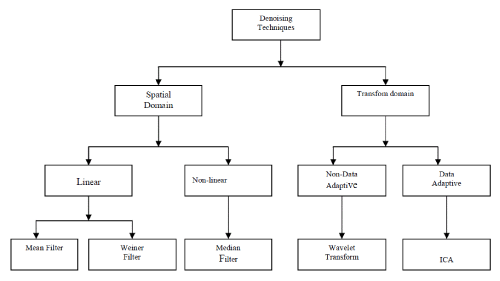 |
| Filters:-It plays a key role in the image restoration procedure. The purpose in the design of a filter to diminish noise is
that it remove as much of the noise as possible while maintaining all of the image qualities.
A mean filter is the one which performs the smoothing of an image when applied on a corrupted image. It reduces the
intensity variation amongst the adjacent pixels. |
| An adaptive filter iteratively adjusts its different parameters during scanning the image to match the image generating
method and it is more important in real time images, which tend to be non-stationary.
Median filter is much superior at preserving sharp edges than the mean filter. These advantages assist median filters in
denoising uniform noise as well from an image. |
| Discrete Wavelet Transform:- It is a wave-like oscillation with amplitude that oscillate between zero and its maximum
peak value. There are four shortcomings, they are Oscillations, Aliasing, Shift Variance and Lack of Directionality
Discrete wavelet transform is suffering from LL band contains the approximation coefficients, LH band contains
horizontal details, HL band contains vertical details and , HH band will contain the diagonal details |
RELATED WORK |
| In the implementation of these methods, first the noisy image is decomposed by dual tree wavelet transform. After this,
by using thresholding shrink decomposed images and apply ad inverse dual tree wavelet transform adaptive wiener
filter to decomposed images. Finally de-noised image is obtained by using inverse dual tree wavelet transform.
In the proposed method an image has been carried out firstly on the basis of adaptive wiener filtering in the wavelet
domain and then on the basis of an adaptive wiener filter in the spatial domain. In this method, to de-noise the image,
following steps follows: |
| • First select an image, check, is it gray image or color image? If color image then firstly convert this image into
gray image. Then use it as input image. |
| • The next step will be to apply Dual Tree Wavelet Transform (DTWT) to decompose the noisy image into six
sub bands. After this adopt wiener filter for each band. |
| • Then reconstructs image by Inverse Dual Tree Wavelet Transform (IDTWT) transform, and gets the de-noised
image. |
| • Wiener filter also adopts to get de-noised image by spatial domain adaptive wiener filtering and also we get
de-noised image by Wavelet. |
| • To process the result of modified de-noising method again apply wiener filter to it. |
| • Finally, calculate PSNR between original image and noisy image and PSNR between the de-noised image and
original image, to make sure a match between wavelet domain adaptive wiener filtering and spatial domain adaptive
wiener filtering. |
| The main benefit of using this method is that it reduces ripples like artefacts around image edges. Hence the de-noised
image has a better visual effect. |
EXPERIMENTAL RESULT |
| Simulation is carried out using MATLAB 2010a |
| Step: 1 - First select an image, check, is it grey image or colour image? If colour image, then firstly convert this image
into grey image. Then use it as input image.Then we add Gaussian noise and make it a noisy image. |
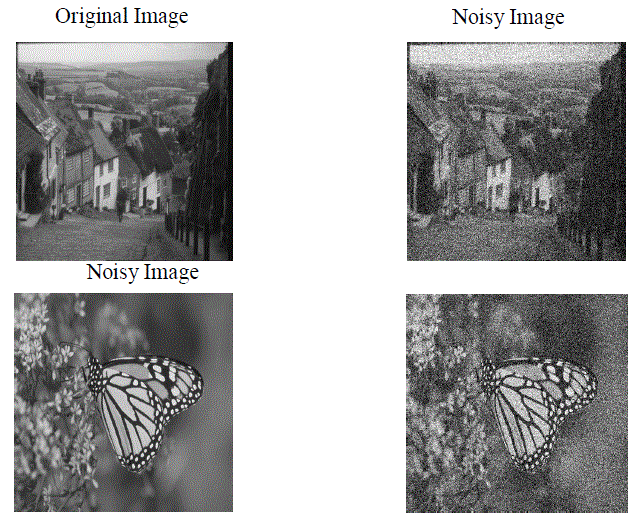 |
| Step: 2 - The next step will be to apply Dual Tree Wavelet Transform (DTWT) to decompose the noisy image into six
sub bands. After this adopt wiener filter for each band. |
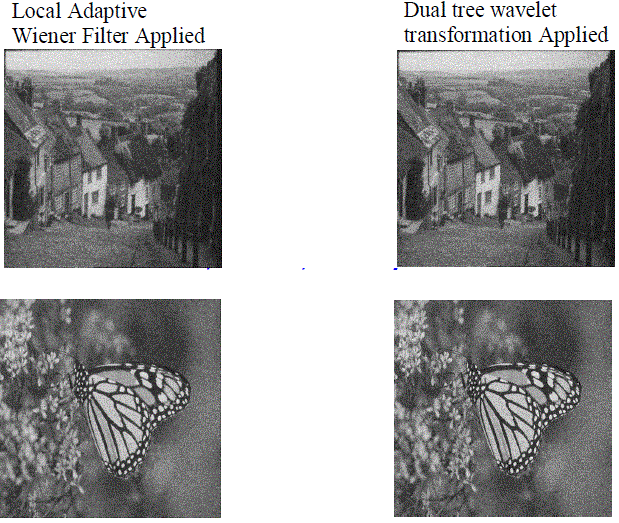 |
| Step: 3 - Then reconstructs image by Inverse Dual Tree Wavelet Transform (IDTWT) transform, and get the de-noised
image. Wiener filter also adopts to get de-noised image by spatial domain adaptive wiener filtering and also we get denoised
image by Wavelet.To process the result of modified de-noising method again apply wiener filter to it. |
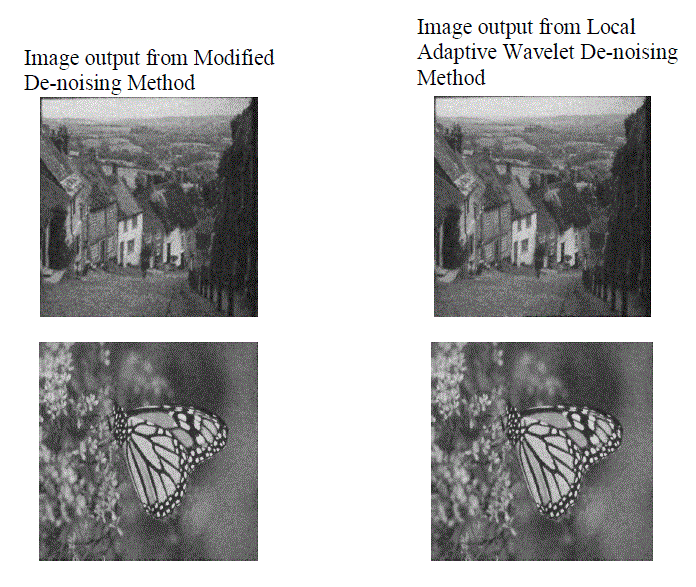 |
| Step: 4 - Finally, calculate PSNR between original image and noisy image and PSNR between the de-noised image and
original image and make sure a match between wavelet domain adaptive wiener filtering and spatial domain adaptive
wiener filtering. |
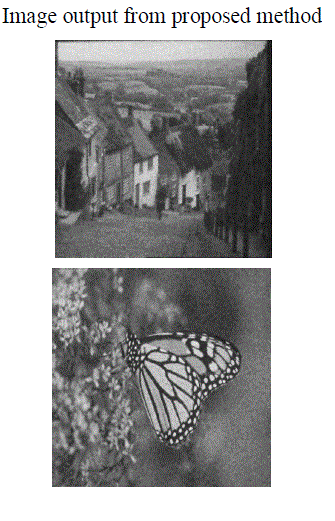 |
| Results of the above process for the two examples are as documents in the tables below. |
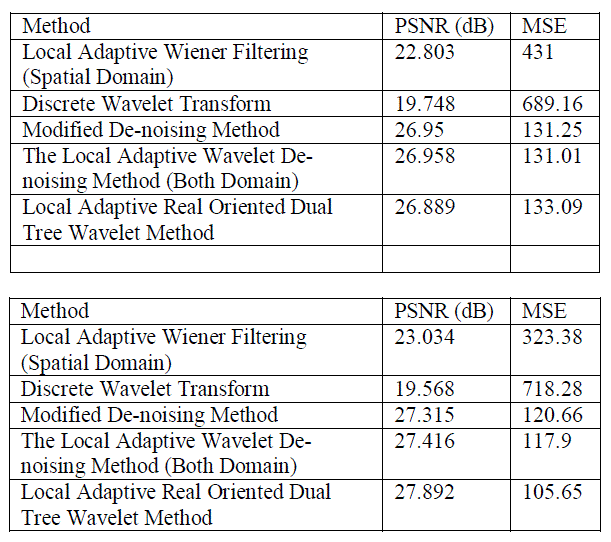 |
CONCLUSION |
| Image de-noising using Local Adaptive Wavelet De-noising Method and Local Adaptive Real Oriented Dual Tree
Wavelet Method has shown a much significant improvement in salt and Gaussian noise. On analysing the results, an
improvement is seen in PSNR, whereas MSE has decreased in the case of proposed method. |
References |
- A. Achim, A. Bezerianos, and P. Tsakalides, ?Novel Bayesian multiscale method for speckle removal in medical ultrasound images,? IEEE Trans. Medical Imaging, vol. 20, no. 8, pp. 772 ? 783, 2001.
- IsrarHussain and Hujun Yin, ?A Novel Wavelet Thresholding Method for Adaptive Image Denoising?, IEEE, ISCCSP Malta, pp.1252-1256, 2008.
- S. KotherMohideen, Dr. S. ArumugaPerumal, Dr. M. Mohamed Sathik, ?Image De-noising using Discrete Wavelet transform?, International Journal of Computer Science and Network Security, IJCSNS, Vol.8 No.1, pp.213-216, January 2008.
- Li Ke, Weiqi Yuan and Yang Xiao, ?An Improved Wiener Filtering Method in Wavelet Domain?, IEEE Trans., ICALIP, pp.1527-1531, August 2008.
- Wenbing Fan, ZhengGe and Yao Wang , ? Adaptive Wiener Filter Based on Fast Lifting Wavelet Transform for image Enhancement", IEEE proceedings of 7th World Congress on Intelligent Control and Automation, pp.3633-3636, 2008.
- Li Hongqiao and Wang Shengqian, ?A New Image Denoising Method Using Wavelet Transform?, IEEE Computer Society, IFITA, pp. 111- 114, 2009.
- Zhao Shuang - ping, ?A Combined Image Denoising Method?, IEEE Trans. IASP, pp.978-1-4244-5555, 2010.
- Xiwen Qin , Yang Yue, Xiaogang Dong, Xinmin Wang and ZhanSheng Tao, ?An Improved Method of Image Denoising Based on Wavelet Transform?, International Conference on Computer, Mechatronics, Control and Electronic Engineering (CMCE), IEEE, pp. 167-170, 2010.
- Li Shixin, Zhang Xinghui and Wang Jianming ?A new Local Adaptive Wavelet Image De-noising Method?, IEEE Computer Society, ISCCS, pp.154-156, 2011.
- Hari Om and MantoshBiswas, ?An adaptive image denoising method based on local parameters optimization?, Sadhana, Indian Academy of Sciences, Vol. 39, Part 4, pp. 879?900, August 2014.
|